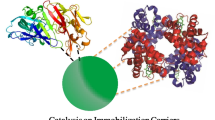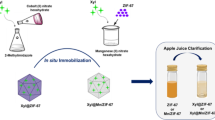Abstract
The immobilization of enzymes improves their stability in non-conventional media such as organic solvents. In this work, the effects of solvents (DMSO, methanol, ethanol, and n-propanol) on the endoglucanase Cel9A activity and stability were studied. Then, the enzymes were stabilized by its immobilization on chitosan nanoparticles and also using polyols (sorbitol and glycerol) against organic solvents. The SEM results illustrated that the chitosan nanoparticles had about 40 nm diameter. The results indicated that the organic solvents, especially n-propanol, decreased the activity of the free and immobilized enzymes. The reduced activity of the immobilized enzyme was less than that of the free enzyme. Our studies about the enzymes’ stability showed that the free and immobilized enzymes in hydrophobic solvents (with high log P) had the lowest stability compared to other solvents as we observed the half-life of the free enzyme in n-propanol solvent was 2.84 min, and the half-life of the immobilized enzyme was 4.98 min in n-propanol and ethanol solvents 4.50 min. Analysis of the combinatory effects of polyols (sorbitol and glycerol) and the solvents on the stability revealed that sorbitol and glycerol had the most stabilizing effect on the free enzyme in hydrophilic (DMSO) and hydrophobic (n-propanol) solvents, respectively. However, the stabilizing effects of polyols in the immobilized enzyme were independent of the solvents’ hydrophobicity (or log P) due to the hydrophilic properties of chitosan nanoparticles. Therefore, one can conclude that the physiochemical properties of nanoparticles (such as hydrophilicity) influence the stabilizing effects of polyols on immobilized enzyme.







Similar content being viewed by others
Abbreviations
- AaCel9A:
-
Endoglucanase Cel9A from Alicyclobacillus acidocaldarius
- ChNPs:
-
Chitosan nanoparticles
- DMSO:
-
Dimethyl sulfoxide
- DNS:
-
Dinitrosalcylic acid
- CMC:
-
Carboxymethyl cellulose
- TPP:
-
Tripolyphosphate
- SEM:
-
Scanning electron microscopy
References
Ansari SA, Husain Q (2012) Potential applications of enzymes immobilized on/in nano materials: a review. Biotechnol Adv 30(3):512–523
Asghari SM, Khajeh K, Dalfard AB, Pazhang M, Karbalaei-Heidari HR (2011) Temperature, organic solvent and pH stabilization of the neutral protease from Salinovibrio proteolyticus: significance of the structural calcium. BMB Rep 44(10):665–668
Badoei-Dalfard A, Khajeh K, Asghari SM, Ranjbar B, Karbalaei-Heidari HR (2010) Enhanced activity and stability in the presence of organic solvents by increased active site polarity and stabilization of a surface loop in a metalloprotease. J Biochem 148(2):231–238
Bayer EA, Shoham Y, Lamed R (2006) Cellulose-decomposing bacteria and their enzyme systems. Prokaryotes 2:578–617
Beguin P (1990) Molecular biology of cellulose degradation. Annu Rev Microbiol 44(1):219–248
Bradford MM (1976) A rapid and sensitive method for the quantitation of microgram quantities of protein utilizing the principle of protein-dye binding. Anal Biochem 72(1–2):248–254
Chen H, Zhang Q, Dang Y, Shu G (2013) The effect of glutaraldehyde cross-linking on the enzyme activity of immobilized β-galactosidase on chitosan bead. Adv J Food Sci Technol 5(7):932–935
Datta S, Christena LR, Rajaram YRS (2013) Enzyme immobilization: an overview on techniques and support materials. 3 Biotech 3(1):1–9
Dong Y, Ng WK, Shen S, Kim S, Tan RB (2013) Scalable ionic gelation synthesis of ChNPs for drug delivery in static mixers. Carbohydr Polym 94(2):940–945
Dong W, Wang K, Chen Y, Li W, Ye Y, Jin S (2017) Construction and characterization of a chitosan-immobilized-enzyme and β-cyclodextrin-included-ferrocene-based electrochemical biosensor for H2O2 detection. Materials 10(8):868–882
Eckert K, Zielinski F, Leggio LL, Schneider E (2002) Gene cloning, sequencing, and characterization of a family 9 endoglucanase (CelA) with an unusual pattern of activity from the thermoacidophile Alicyclobacillus acidocaldarius ATCC27009. Appl Microbiol Biotechnol 60(4):428–436
Eckert K, Vigouroux A, Leggio LL, Moréra S (2009) Crystal structures of A. acidocaldarius endoglucanase Cel9A in complex with cello-oligosaccharides: strong − 1 and − 2 subsites mimic cellobiohydrolase activity. J Mol Biol 394(1):61–70
Griebenow K, Klibanov AM (1996) On protein denaturation in aqueous–organic mixtures but not in pure organic solvents. J Am Chem Soc 118(47):11695–11700
Hemsworth GR, Henrissat B, Davies GJ, Walton PH (2014) Discovery and characterization of a new family of lytic polysaccharide monooxygenases. Nat Chem Biol 10(2):122–126
Homaei AA, Sariri R, Vianello F, Stevanato R (2013) Enzyme immobilization: an update. J Chem Biol 6(4):185–205
Hong SM, Sung HS, Kang MH, Kim C-G, Lee Y-H, Kim D-J, Lee JM, Kusakabe T (2014) Characterization of Cryptopygus antarcticus endo-β-1, 4-glucanase from Bombyx mori expression systems. Mol Biotechnol 56(10):878–889
Khajeh K, Ranjbar B, Naderi-Manesh H, Habibi AE, Nemat-Gorgani M (2001) Chemical modification of bacterial α-amylases: changes in tertiary structures and the effect of additional calcium. Biochimica et Biophysica Acta (BBA)-Protein Structure and Molecular Enzymology 1548(2):229–237
Khmelnitsky YL, Mozhaev VV, Belova AB, Sergeeva MV, Martinek K (1991) Denaturation capacity: a new quantitative criterion for selection of organic solvents as reaction media in biocatalysis. Eur J Biochem 198(1):31–41
Klibanov AM (1997) Why are enzymes less active in organic solvents than in water? Trends Biotechnol 15(3):97–101
Klibanov AM (2001) Improving enzymes by using them in organic solvents. Nature 409(6817):241–246
Krajewska B (2004) Application of chitin-and chitosan-based materials for enzyme immobilizations: a review. Enzyme Microb Technol 35(2–3):126–139
Kuhad RC, Gupta R, Singh A (2011) Microbial cellulases and their industrial applications. Enzyme Res 2011:280696
Kumar V, Chari R, Sharma VK, Kalonia DS (2011) Modulation of the thermodynamic stability of proteins by polyols: significance of polyol hydrophobicity and impact on the chemical potential of water. Int J Pharm 413(1–2):19–28
Kumari A, Mahapatra P, Kumar GV, Banerjee R (2008) Comparative study of thermostabilty and ester synthesis ability of free and immobilized lipases on cross linked silica gel. Bioprocess Biosyst Eng 31(4):291–298
Lee JC, Timasheff SN (1981) The stabilization of proteins by sucrose. J Biol Chem 256(14):7193–7201
Lee M, Chen B-Y, Den W (2015) Chitosan as a natural polymer for heterogeneous catalysts support: a short review on its applications. Appl Sci 5(4):1272–1283
Lynd LR, Weimer PJ, Van Zyl WH, Pretorius IS (2002) Microbial cellulose utilization: fundamentals and biotechnology. Microbiol Mol Biol Rev 66(3):506–577
Mardani T, Khiabani MS, Mokarram RR, Hamishehkar H (2018) Immobilization of α-amylase on chitosan-montmorillonite nanocomposite beads. Int J Biol Macromol 120(Pt A):354–360
Matsumoto M, Kida K, Kondo K (1997) Effects of polyols and organic solvents on thermostability of lipase. J Chem Technol Biotechnol 70(2):188–192
Matulis D, Wu C, Van Pham T, Guy C, Lovrien R (1999) Protection of enzymes by aromatic sulfonates from inactivation by acid and elevated temperatures. J Mol Catal B Enzym 7(1–4):21–36
Miller GL (1959) Use of dinitrosalicylic acid reagent for determination of reducing sugar. Anal Chem 31(3):426–428
Milstein O, Nicklas B, Hüttermann A (1989) Oxidation of aromatic compounds in organic solvents with laccase from Trametes versicolor. Appl Microbiol Biotechnol 31(1):70–74
Miroliaei M, Nemat-Gorgani M (2002) Effect of organic solvents on stability and activity of two related alcohol dehydrogenases: a comparative study. Int J Biochem Cell Biol 34(2):169–175
Ogino H, Gemba Y, Yutori Y, Doukyu N, Ishimi K, Ishikawa H (2007) Stabilities and conformational transitions of various proteases in the presence of an organic solvent. Biotechnol Prog 23(1):155–161
Pahujani S, Kanwar SS, Chauhan G, Gupta R (2008) Glutaraldehyde activation of polymer Nylon-6 for lipase immobilization: enzyme characteristics and stability. Biores Technol 99(7):2566–2570
Pazhang M, Khajeh K, Ranjbar B, Hosseinkhani S (2006) Effects of water-miscible solvents and polyhydroxy compounds on the structure and enzymatic activity of thermolysin. J Biotechnol 127(1):45–53
Pazhang M, Mehrnejad F, Pazhang Y, Falahati H, Chaparzadeh N (2016) Effect of sorbitol and glycerol on the stability of trypsin and difference between their stabilization effects in the various solvents. Biotechnol Appl Biochem 63(2):206–213
Pazhang M, Mardi N, Mehrnejad F, Chaparzadeh N (2018a) The combinatorial effects of osmolytes and alcohols on the stability of pyrazinamidase: methanol affects the enzyme stability through hydrophobic interactions and hydrogen bonds. Int J Biol Macromol 108:1339–1347
Pazhang M, Younesi FS, Mehrnejad F, Najavand S, Tarinejad A, Haghi M, Rashno F, Khajeh K (2018b) Ig-like domain in endoglucanase Cel9A from Alicyclobacillus acidocaldarius makes dependent the enzyme stability on calcium. Mol Biotechnol 60(9):698–711
Pereira JH, Sapra R, Volponi JV, Kozina CL, Simmons B, Adams PD (2009) Structure of endoglucanase Cel9A from the thermoacidophilic Alicyclobacillus acidocaldarius. Acta Crystallogr D Biol Crystallogr 65(8):744–750
Petersen SB, Jonson V, Fojan P, Wimmer R, Pedersen S (2004) Sorbitol prevents the self-aggregation of unfolded lysozyme leading to an up to 13 C stabilisation of the folded form. J Biotechnol 114(3):269–278
Pliura DH, Jones JB (1980) Effects of organic solvents on immobilized enzyme catalyses: chymotrypsin immobilized on Sephadex. Can J Chem 58(23):2633–2640
Rahimizadeh P, Najavand S, Pazhang M (2015) A comparative study of activity and stability of the free and the immobilized endoglucanase from Alicyclobacillus acidocaldarius. Biomacromol J 1(2):167–176
Rampino A, Borgogna M, Blasi P, Bellich B, Cesàro A (2013) ChNPs: preparation, size evolution and stability. Int J Pharm 455(1–2):219–228
Sadhu S, Maiti TK (2013) Cellulase production by bacteria: a review. British Microbiol Res J 3(3):235–258
Sambrook J, Fritsch EF, Maniatis T (1989) Molecular cloning: a laboratory manual, 2nd edn. Cold Spring Harbor Laboratory Press, Cold Spring Harbor
Sarkar N, Ghosh SK, Bannerjee S, Aikat K (2012) Bioethanol production from agricultural wastes: an overview. Renew Energy 37(1):19–27
Sellek GA, Chaudhuri JB (1999) Biocatalysis in organic media using enzymes from extremophiles. Enzyme Microb Technol 25(6):471–482
Simon L, Kotorman M, Garab G, Laczko I (2001) Structure and activity of α-chymotrypsin and trypsin in aqueous organic media. Biochem Biophys Res Commun 280(5):1367–1371
Street TO, Bolen DW, Rose GD (2006) A molecular mechanism for osmolyte-induced protein stability. Proc Natl Acad Sci 103(38):13997–14002
Timasheff SN (1998) Control of protein stability and reactions by weakly interacting cosolvents: the simplicity of the complicated. Adv Protein Chem 51(51):355–432
Timasheff SN (2002) Protein-solvent preferential interactions, protein hydration, and the modulation of biochemical reactions by solvent components. Proc Natl Acad Sci 99(15):9721–9726
Tjernberg A, Markova N, Griffiths WJ, Hallén D (2006) DMSO-related effects in protein characterization. J Biomol Screen 11(2):131–137
Trevan MD (1980) Immobilized enzymes: an introduction and application in biotechnology. Wiley, Chichester, UK
Tsuzuki W, Ue A, Nagao A (2003) Polar organic solvent added to an aqueous solution changes hydrolytic property of lipase. Biosci Biotechnol Biochem 67(8):1660–1666
Ulbrich-Hofmann R, Arnold U, Mansfeld J (1999) The concept of the unfolding region for approaching the mechanisms of enzyme stabilization. J Mol Catal B Enzym 7(1–4):125–131
Vagenende V, Yap MG, Trout BL (2009) Mechanisms of protein stabilization and prevention of protein aggregation by glycerol. Biochemistry 48(46):11084–11096
Wan Y-Y, Lu R, Xiao L, Du Y-M, Miyakoshi T, Chen C-L, Knill CJ, Kennedy JF (2010) Effects of organic solvents on the activity of free and immobilised laccase from Rhus vernicifera. Int J Biol Macromol 47(4):488–495
Wong LS, Thirlway J, Micklefield J (2008) Direct site-selective covalent protein immobilization catalyzed by a phosphopantetheinyl transferase. J Am Chem Soc 130(37):12456–12464
Zhan D, Du Y, Qian B (1991) Study of immobilized laccase and its properties. Chem Indus For Prod 11:111–116
Author information
Authors and Affiliations
Corresponding author
Ethics declarations
Conflict of interest
The authors declare that there are no conflicts of interest.
Rights and permissions
About this article
Cite this article
Mohammadi, M., Najavand, S. & Pazhang, M. Immobilization of endoglucanase Cel9A on chitosan nanoparticles leads to its stabilization against organic solvents: the use of polyols to improve the stability. 3 Biotech 9, 269 (2019). https://doi.org/10.1007/s13205-019-1794-5
Received:
Accepted:
Published:
DOI: https://doi.org/10.1007/s13205-019-1794-5




